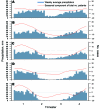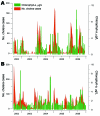Dynamics of cholera outbreaks in Great Lakes region of Africa, 1978-2008
- PMID: 22099090
- PMCID: PMC3310557
- DOI: 10.3201/eid1711.110170
Dynamics of cholera outbreaks in Great Lakes region of Africa, 1978-2008
Abstract
Cholera outbreaks have occurred in Burundi, Rwanda, Democratic Republic of Congo, Tanzania, Uganda, and Kenya almost every year since 1977-1978, when the disease emerged in these countries. We used a multiscale, geographic information system-based approach to assess the link between cholera outbreaks, climate, and environmental variables. We performed time-series analyses and field investigations in the main affected areas. Results showed that cholera greatly increased during El Nino warm events (abnormally warm El Ninos) but decreased or remained stable between these events. Most epidemics occurred in a few hotspots in lakeside areas, where the weekly incidence of cholera varied by season, rainfall, fluctuations of plankton, and fishing activities. During lull periods, persistence of cholera was explained by outbreak dynamics, which suggested a metapopulation pattern, and by endemic foci around the lakes. These links between cholera outbreaks, climate, and lake environments need additional, multidisciplinary study.
Figures






References
Publication types
MeSH terms
LinkOut - more resources
Full Text Sources
Medical
